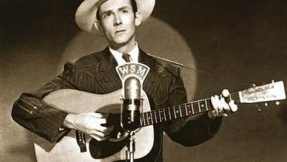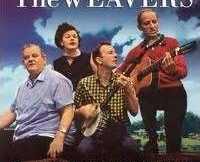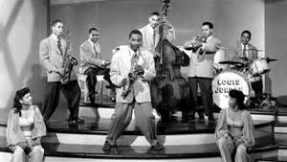Exploring the Roots of Rock ‘n’ Roll, 1947-1953

Though considered the breakthrough year for rock ‘n’ roll, especially in the realms of R&B crossovers to the pop chart, 1954 was really a continuation of what was happening at least since 1947. What caused this tipping point, however, was the fact in 1954 Elvis Presley got involved, with his cover of the Arthur “Big Boy” Crudup blues tune, “That’s All Right, Mama,” originally released in 1947. This single caused a big stir in Memphis and some other parts of the country, but failed to dent even the R&B charts.
Blues, doo-wop, and R&B were the dominant genres of ’54. The wistful harmonies of The Harptones, The Clovers, The Chords, The Penguins, The Jewels, The Charms, The Crows, The Diablos, The Spaniels, The Cadillacs, and Marvin and Johnny cropped up on street corners under the moon of love, from Harlem to Detroit to East L.A., always on the verge of going out of tune. In the R&B sphere, Big Joe Turner, Hank Ballard and The Midnighters, and Clyde McPhatter with The Drifters gained some notoriety with their racy lyrics, which often resulted in their tunes being banned from the radio, even the stations at the far left and far right of the dial, where discerning future musicologists in the audience got their R&B fixes, usually pointing their antennas toward Cleveland. Several big voiced women joined the party: Ruth Brown, Lavern Baker, and Marie Adams, along with Shirley Gunter, fronting arguably the first doo wop girl group, The Queens. One of the last good years for a blues singer to hit the charts, 1954 gave us stellar sides by B.B. King, Muddy Waters, Guitar Slim, and Howlin’ Wolf.
Aside from Elvis, the closest thing in 1954 to what would come to be known as rock ‘n’ roll was provided by Richard Berry, the uncredited voice in Leiber & Stoller’s “Riot in Cell Block No. 9,” with The Robins, and his own “The Break Out,” which not only foretold the coming musical revolution, but the next one as well, with echoes of gangsta rap. Berry would further cement his legendary status by writing and recording “Louie Louie” a year later.

1947 was a particularly plush year for roots music, featuring another of Elvis’ early sides, “Blue Moon of Kentucky,” written and recorded by bluegrass legend Bill Monroe. Mournful country star Hank Williams’ first hit in ’47, with the rockin’ “Move It on Over”–which introduced the “dog” metaphor to the literature of rock ‘n’ roll (one which certainly appealed to Elvis). Western swing pioneer Bob Wills penned “Ida Red” in 1947, a tune that was purported to be one of the inspirations behind Chuck Berry’s “Maybellene,” which topped the charts in 1955.

1948 provided one of pop culture’s early signature doo wop moments with “It’s Too Soon to Know” by the Orioles. In 1949 jump blues master Louis Jordan gave us the ultimate R&B party song, “Saturday Night Fish Fry,” complete with sex, drugs, and the cops arriving on the scene. Also in ’49, the Weavers hit the charts with “If I Had a Hammer,” previewing the folk boom of 1958 and the folk scare of 1963.
With Hank Williams, Louis Jordan, and The Weavers firmly rooted in the pop landscape, the role of the 1940s in the grand cultural scheme called rock ‘n’ roll was solidified. Hank provided at least enough lonesome images of lost highways and lost loves to compete with Woody Guthrie as Bob Dylan’s prime early poetic mentor. With Pete Seeger as their spiritual and philosophical leader, The Weavers added weight to the conversation that would only become two-sided when Dylan joined forces with the Beatles to give us the late ’60s heyday of folk/rock. Louis Jordan’s raucous template for R&B lasted for well over thirty years, until it was turned upside down and inside out by a less sympathetic and/or malleable generation of Black protest singers.

In 1950 the first electric rumblings of Chicago blues became an important part of the future rock ‘n’ roll mix, with Chess stalwarts Howlin’ Wolf (“Moanin at Midnight”) and Muddy Waters (“Rollin Stone”) leading the way. Down in New Orleans, Fats Domino had his first of 38 Top 10 R&B hits, appropriately dubbed “The Fat Man.” In 1951 The Dominos released their first song deemed to be salacious enough to be banned from the radio, “Sixty Minute Man,” while “Rocket 88” by Jackie Brenston and His Delta Cats brought Sam Phillips and Sun Records into the marketplace (with Jackie on the sax and Ike Turner on keyboards). Also in ’51, Les Paul launched the sound that sold a million (Les Paul) guitars, in “How High the Moon,” with Mary Ford on vocals. Brother Ray Charles released the classic “Sinner’s Prayer” in 1952, written by the man he played keyboards for, guitarist Lowell Fulson, as the b-side of Ray’s first Atlantic single, “It Should’ve Been Me.” The same year, 17-year old Lloyd Price attempted to wrest the chalice of New Orleans R&B from Fats Domino, with the Number one single “Lawdy Miss Clawdy,” with Fats’ band backing him up, and Fats on piano. While Kitty Wells imprinted the girl gone wrong image all over the next fifty years of country music with “It Wasn’t God Who Made Honky Tonk Angels.”
In 1953, Marie Adams merged doo wop and R&B, for the Herald label’s first hit, “Shake a Hand” and Junior Parker introduced another future Elvis classic, “Mystery Train.” But the last two pieces of the puzzle added in 1953 were the ones that might have given the discerning musicologists in the audience the most pause, even as they filled them with delight. With roots firmly planted in the R&B and rockabilly undergrounds, “Hound Dog” and “(We’re Gonna) Rock Around the Clock” at first appear to be textbook gems of their divergent forms, on the verge of merging into rock ‘n’ roll. Consider especially the fantastic guitar solo of Danny Cedrone on “Rock” and the guttural growl of Big Mama Thornton in “Dog,” which established her as a definite soul sister to Big Maybelle, as well as the reigning triumvirate of Baker, Brown, and Adams, with a song written and produced by future Brill Building superstars Jerry Leiber & Mike Stoller.
In the heart of Broadway, the Brill Building, with its expanding tenant list of independent music publishers, would become an historic a hit-making edifice, rivaling anything found in Detroit or Los Angeles. It was arguably a key factor in refining (some might say taming) the rock ‘n’ roll beast before it really left the cage, and turning it into something that could be easily mass produced, thus controlled. This was where the team of Max Freedman and Jimmy DeKnight (writing under the name of Jimmy Myers) operated in semi-obscurity, offering “Rock Around the Clock” to Sunny Dee in ’52, before Bill Haley and His Comets stiffed with it in ’53. And then, significantly and ominously, Hollywood stepped into the mix. When DeKnight was appointed music supervisor to the film Blackboard Jungle it was hardly a coincidence that he chose the Bill Haley tune to feature behind the opening credits and later during a key scene in the movie (adopting the Myers pseudonym to ward off any conflict of interest charges). The tune hit the top of the pop charts in 1955, thus establishing rock ‘n’ roll as a sound and an image–and a vehicle Hollywood could exploit.

Similarly, “Hound Dog” might have languished in the dusty bins of R&B history had Elvis not chanced upon it in that formidable rock ‘n’ roll hotbed, Las Vegas, where a lounge act had turned it into an innocuous novelty. While a step down from Thornton’s wry and ribald take on the “dog” in question–a close relation to Hank Williams’ “big dog” from “Move It on Over”–El’s version was nonetheless a bit more provocative than the one being purveyed by the group he stole it from, provocative enough, with the aid of a few strategic televised appearances, courtesy of Steve Allen, Milton Berle, and Ed Sullivan, to top the pop, R&B, and country charts in 1956, a rare trifecta never before accomplished.
Thus, nurtured on the fertile fields of Harlem, East L.A., New Orleans, Memphis, Chicago, and Detroit, rock ‘n’ roll had to turn to Broadway, Hollywood, and Las Vegas to get it over the top. In that light, it may have been doomed from the start.
But it was fun while it lasted.
What do you think? Leave a comment.











Good summery of the roots of RnR. It remains my choice of genre, and I listen to the other musical genres it got its roots from too.
I’ve noticed a few factual errors here. I wonder if anyone else will.
Thanks! Basically, the music has its roots in black southern gospel and rhythm & blues.
I’m curious if you’ve heard Yeezus (Kanye West) and have any opinions on it. You seem like you know your music well!
: )
The only problem I have with Kanye is his persona. As far as his lyrics and songs go, the man is a genius.
I find it amazing how anyone can appreciate modern music while being totally ignorant of its rich origins. Thanks for an excellent treatment of the topic.
Thanks for the comment. I’m presently working on a year by year account of the history of rock ‘n’ roll.
As far as the factual errors alluded to above; further research has indicated that co-writer Myers may not have been the music supervisor on Blackboard Jungle. He may not have had anything to do with the writing of the song either–although he retains a credit. The fact that “Rock Around the Clock” exploded into public consciousness after its use in the movie remains unassailable.
Good article, you should go more in depth on some of the bands and branching genres!
While this is a nice summary of the American founding fathers of rock, it could truly be traced all the way back to the slave trade. Nearly all music which is present in modern America can be analyzed as an offshoot of the blues which Africans sung during slave times. Sadly enough, it’s the one good thing that came of slave trading.
Interesting take on the roots of Rock ‘N’ Roll. I love rock music because it is so transformative. It takes elements of sound from all walks of life, from years past and present and makes something truly meaningful and emotional.
I hadn’t considered the whole notion of the dog as rock symbol. “Black Dog” by Led Zeppelin came to mind immediately. How do you think this symbol lends itself to the genre?
Interesting article on the foundations of rock’n roll music. I think it is important that people know where today’s music comes from, and discovers the musical treasures of the past. Thank you for this!
Glad to finally see something about rock and roll on here! You seem to know my favorite genre well, and I certainly appreciate that you’ve done your research 🙂
Great exploration into the roots of rock and roll. It really helps appreciate this genre even more.
This is such an excellent exploration of something that I think more people should know about. Thanks for sharing!
I believe the beginning of the end of 1950’s Rock ‘n’ Roll was Paul Anka’s 1957 record “Diana,” ushering in the era of the slick, Philly sound of Italo – American Elvis clones – e.g., Fabian, Frankie Avalon, etc. that lasted until 1964.
Citation needed.
“Citation” not needed – Just listen to this particular musical genre and look at images of these performers. It’s pretty self-evident.
Enjoyed this article immensely. Love old time rock n’ roll…
Thanks for writing it.
The term “Rock ‘n’ Roll, or “Rock and Roll” as applied to a particular musical genre was coined by DJ Alan Freed in 1951, who defined it as: “Any Rhythm and Blues song (and by extension, recording) that is UPBEAT.”